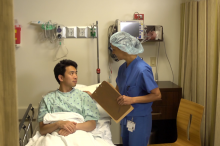Losing an eye can be a very emotionally taxing event, and at the Orbital Surgery Center of Excellence, we understand the delicate nature of working with patients who have suffered this loss. Our oculoplastic surgeons trained in top programs, and specialize in minimally invasive treatments within the orbital area, including removal of the eye.
Surgical removal of an eye is most often only performed in severe cases, where conservative methods have been unsuccessful. Most often, removal of the eye is performed in order to relieve pain in blind eyes, as well as to improve the aesthetic appearance of a disfigured eye. However, evisceration may also be necessary for patients who have suffered a severe eye injury.
About Evisceration
Each case is unique and requires a specialized treatment plan and team of board-certified surgeons. One type of eye removal surgery is called evisceration.
Unlike enucleation, which involves the complete removal of the eye, evisceration is the surgical removal of the contents of the eye, leaving the white part of the eye and the eye muscles intact. Most commonly, your surgeon will remove part of the eye and fit a prosthetic eye over it to improve the appearance of the eye, making it look more natural.
Evisceration Surgery
Evisceration can often be performed on an outpatient basis under general anesthesia, although in some cases, local anesthesia with sedation may be sufficient. While some patients are required to stay the night at the outpatient surgery center, many are able to go home the same day. When you are planning to undergo eye surgery at our center, please make sure to arrange for a ride to and from the surgery center prior to your procedure, and be sure to have a friend or family member to stay with you the first night at home after surgery.
During the procedure, your surgeon will typically use an implant made of polyethylene, alumina, or silicone rubber, forming it into a sphere shape and then placing it into the eye. In most cases, the patient’s own tissue can be used to cover the eye, with their eye muscles attached to the implant to allow natural eye movement. The implant is used to help restore more natural volume that is lost during eye removal surgery.
Prosthetics and Artificial Eyes
An artificial eye is made after surgery when your eye has healed. The prosthesis (artificial eye) is custom made and designed to match your other eye. Additionally, the back of the prosthesis is also created to fit the eye shape exactly. This detailed designing allows for maximum movement and comfort, as well as the appearance of balanced eyes. Prosthetic eyes typically last many years, and are easily removable for cleaning. In some cases, a peg can actually be inserted into the implant, attaching to the prosthesis to allow better movement. However, the use of a peg is not possible in all artificial eye cases.
After Evisceration Surgery
Following your evisceration surgery, your surgeon will give you specific post-operative instructions to follow. These guidelines will help you to heal as quickly as possible, and without complications, so it is important to follow them exactly. Depending on your unique case, you may need to wear an eye patch for several weeks until the eye has healed. Throughout the recovery period, it is important to follow up with your doctor because your eye tissue may change shape during the healing process. Following up ensures your surgeon can confirm that the socket is healthy during your aftercare appointments.
Contact and Expert Eye Surgeon in Los Angeles
If you have suffered an eye injury or are interested in learning more about eye removal and reconstruction surgery, it is important to speak with an ophthalmic plastic and reconstructive surgeon who specializes in diseases and conditions of the eyelids, tear duct, and orbit (the area around the eye).
To contact one of our surgeons, please contact the Orbital Surgery Center of Excellence. You can schedule a consulation by calling (888) 559-4341, or you can make your appointment online.
Next, learn more about eye tumors.














